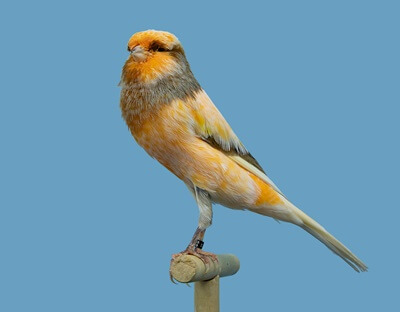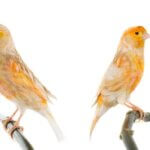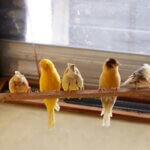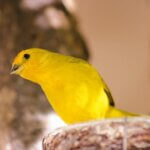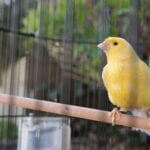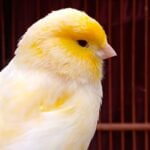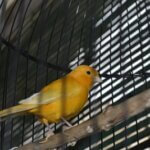The Yorkshire canary is characterized by its proud and upright stance, which has earned it the nicknames “Gentleman of the Fancy” and “the Guardsman.”
While the breed has notably changed since it was first developed more than two centuries ago, it has retained its iconic, slender appearance and tall gait. The Yorkshire canary is the longest and among the largest of all canaries.
Breeding and raising Yorkshire canaries is possible, but preparation is key. Like all canaries, Yorkshires value space, privacy, and quiet, which can be harder to achieve with their larger size.
How Did Yorkshire Canaries Get Their Name?
The Yorkshire canary is a “type canary,” mainly bred for its overall physical appearance rather than its song or a particular color.
The history of the Yorkshire canary starts in Bradford, England, in the mid-19th century, where it was first bred and then shown in 1870. This debut took place in Yorkshire, hence the canary’s name.
The increasing popularity and demand for Yorkshire canaries in the late 1800s contributed to the formation of the Yorkshire Canary Club in 1894.
The objective was to decide the quality standards for this type of canary. Even so, the desired standard for the Yorkshire canary, as we know it today, wasn’t achieved until 1935.
The Yorkshire canary is a crossbreed developed from the Norwich canary, the Lancashire canary, and the Belgian bult canary. So, it takes the best traits from these birds, including:
- Color
- Feather quality
- Stance
- Vigor
Social Behavior
Yorkshire canaries are friendly and good-natured birds living well in cages and aviaries.
They’re timid creatures that shouldn’t be kept with more territorial and aggressive birds, such as hookbills, budgies, and lovebirds.
Despite that, Yorkshire canaries get along well with other canary species and less aggressive finch breeds, like Zebra finches, Bengalese finches, and Gouldian finches.
Ideally, male Yorkshire canaries should be placed in individual cages since keeping them in pairs or groups can lead to fights.
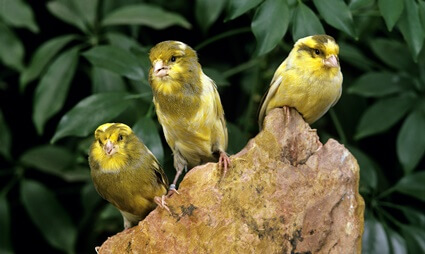
What Do Yorkshire Canaries Look Like?
Since Yorkshire canaries are desired for their overall appearance, they match and diverge from more standard canaries in these ways:
Color
Yorkshire canaries come in a wide range of colors and hues, the most common being yellow. Other colors and combinations include:
- Green
- Buff
- White
- Cinnamon
- Black-brown
Size
The Yorkshire canary is the largest breed of its kind in terms of length.
The average length of a fully-grown one is about 6 – 6.5 inches (15.5 – 16.5 cm). This variety is bred to have a narrow waist, large chest and shoulders, and a rigidly straight posture.
Weight
The average weight of a Yorkshire canary is about 0.4 – 1.1 oz. (12 – 30g). This is heavier than the typical Atlantic (or common) canary.
Yorkshire Canary Breeding
Despite their larger size, Yorkshire canaries are no harder to breed than other canary types.
They may be picky about their cage, diet, and mates, but this is true for all canaries, which are known to be tricky to breed.
Here’s a guide on how to breed Yorkshire canaries:
Choosing Your Canary Pair
Selecting the right pair of Yorkshire canaries is necessary for successful breeding. There are two main factors you must consider in advance:
- Sexual maturity
- Health
According to Behavioral and Neural Biology, male canaries sexually mature about 8 -12 months after hatching. However, female canaries may be ready for breeding as early as 5-6 months of age.
Despite this, you should hold off on breeding until the male and female canaries are fully mature to avoid health complications.
After that, ensure the pair you choose is in peak health. This includes being fed a calcium and protein-rich diet, given plenty of exercise, topped up on vitamins and minerals, and free of any illness.
Even if your canaries appear healthy, it’s wise to have them checked by a vet before breeding. Birds are skilled at hiding illness, and a deficiency can lead to unsuccessful breeding or weak eggs.
Ideally, you should choose young and energetic birds with quality feathers. Healthy and sexually ready males tend to be active and spend lots of time singing. Healthy females ready for breeding will display nesting behaviors, such as nest-building and crouching frequently.
Breeding Cage
Yorkshire canaries require a more spacious cage to enter the condition and breed.
Even if your typical cage suits the birds out of mating season, upgrading to a larger one can make the pair comfortable and improve the odds of successful breeding. That’s especially true since Yorkshire canaries are larger than the standard types.
If you keep multiple canaries or birds, be sure to separate the breeding pair from the others so they have the privacy to reproduce. Likewise, this prevents territorial stress or any fights as the breeding pair work to defend their nesting area.
Diet
Yorkshire canaries require a high-protein diet during the breeding season, which helps them meet the energy requirements for mating and caring for their fledglings.
Recommended protein-rich foods include hard-boiled eggs, formulated pellets, and seed mixes. Adding carotenoids (such as those found in carrots) to the diet keeps the birds healthy and makes their feathers more colorful, and this will be reflected in the chicks they produce.
Regarding females specifically, canary hens require extra calcium when they are in condition. This aids in producing healthy eggs and can help prevent issues like egg-binding or soft shells, which may be life-threatening. Ideal sources include:
- Cuttlebone
- Eggshells
- Fresh leafy greens
Nesting Material
Canaries prefer to lay their eggs and brood in shallow nests. Nesting pans are easy to buy from pet stores and bird supply shops and must be installed at the edge of the cage.
This is important since canaries refuse to breed without privacy and quiet. That goes for Yorkshires as well, especially because of their size.
Make sure the nesting pan is large enough to comfortably house the female. After that, be certain to obscure the nesting area with decorations, a blanket over the cage, or otherwise angle the cage, so it’s secluded from the rest of the room.
Aside from this, provide your female canary with ample nesting materials, allowing her to pad, insulate, and arrange the nest to her liking.
Not only will that imitate her natural process in the wild, but it’ll help the female canary prepare for breeding and produce the necessary hormones. Recommended materials include:
- Lint
- Cotton strips
- Shredded paper
Just be sure to avoid nylon and polyester strings or anything that can fray since your canary is likely to get its feet dangerously entangled.
The Canary Breeding Process
Prepare your birds for the best chance of successfully breeding Yorkshire canaries. Keeping them near full-spectrum lights is one of the simplest ways to nudge them into a breeding mood.
Expose your canaries to this light for at least 12 hours a day. This mimics the natural day-night cycle they would experience in the wild during mating season and thus encourages hormone production for breeding. If you’re using artificial lights, set a timer so the lights automatically follow the set schedule.
The canaries are ready to breed when they display courtship and nesting behavior. In males, this will manifest as louder and more frequent singing, regurgitation, and dancing. Females will respond positively to these gestures and start building a nest with the materials you’ve offered.
Egg Laying
Yorkshire canaries raise a maximum of three broods per season and lay about 3-5 eggs per batch.
They typically lay one egg each day in the early morning. When the female is done laying her entire clutch, she will start to brood on them.
You must wait at least six days to determine whether the eggs are viable. At that point, you can check by holding a flashlight against them in a dark room. Look for a dark red color or spots. If the egg appears translucent, it’s likely infertile.
Remove non-viable eggs from the nest to create space for the fertile ones. This will also prevent the dead eggs from rotting in the nest, which can produce bacteria and fungi.
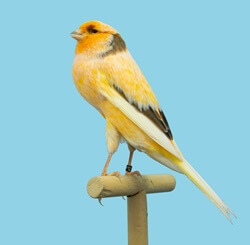
Separate The Male and Female
Once your Yorkshire canaries have mated and produced a clutch, your hen will need a peaceful environment to brood and hatch the offspring, and this is part of what makes breeding so difficult.
Keep the male canary in the same space but in a separate cage. Failing to separate the pair can lead to the female abandoning, damaging, or poorly incubating her clutch.
In severe cases, the pair may even fight, as the male will be interested in continued breeding, and the female will refuse so that she can tend to her clutch. At the very least, the female will become stressed and ignore her eggs; at the worst, the female could be injured.
Hatching
About two weeks after the final egg is laid, Yorkshire chicks will begin to hatch. The hatchlings are roughly the size of a thumbnail when they first emerge.
New canary chicks are efficient feeders and open their beaks to receive a meal when their mother approaches the nest.
Canary parents are devoted to their offspring and often sit on the chicks until they are fledglings. They should only leave to eat and feed the young by regurgitating into their beaks.
Caring for Canaries Chicks
Once the hard part of breeding canaries is finished, the hatchlings are easy to care for, and they only require consistent feeding (at least once every 2 hours).
According to Biological Sciences, canary parents are highly attuned to their chicks’ posturing behavior and vocalizations and will always respond by feeding them.
In rare cases, some baby canaries struggle to catch their parents’ attention when hungry, and you might have to supplement this by hand-feeding these weaker chicks.
Beyond that, some breeders recommend hand-feeding checks even outside of necessity. Hand-reared chicks are often more social, friendly, and comfortable with handling..
Chick formula can be purchased at pet stores or online. Day-old chicks should be fed a diluted mixture (90% liquid) instead of solid foods since they still utilize the egg’s yolk sac. However, baby canaries older than 1-2 days should be fed a mix that’s 70-75% liquid.
A syringe is recommended since it’s easier to deliver and monitor the amount of food you’re giving the chick. Your chick is eating properly if it bobs its head quickly.
When this happens, the trachea closes, thus enabling your canary chick to swallow. Don’t feed the chick if it lacks this reaction, which can result in food aspiration.

